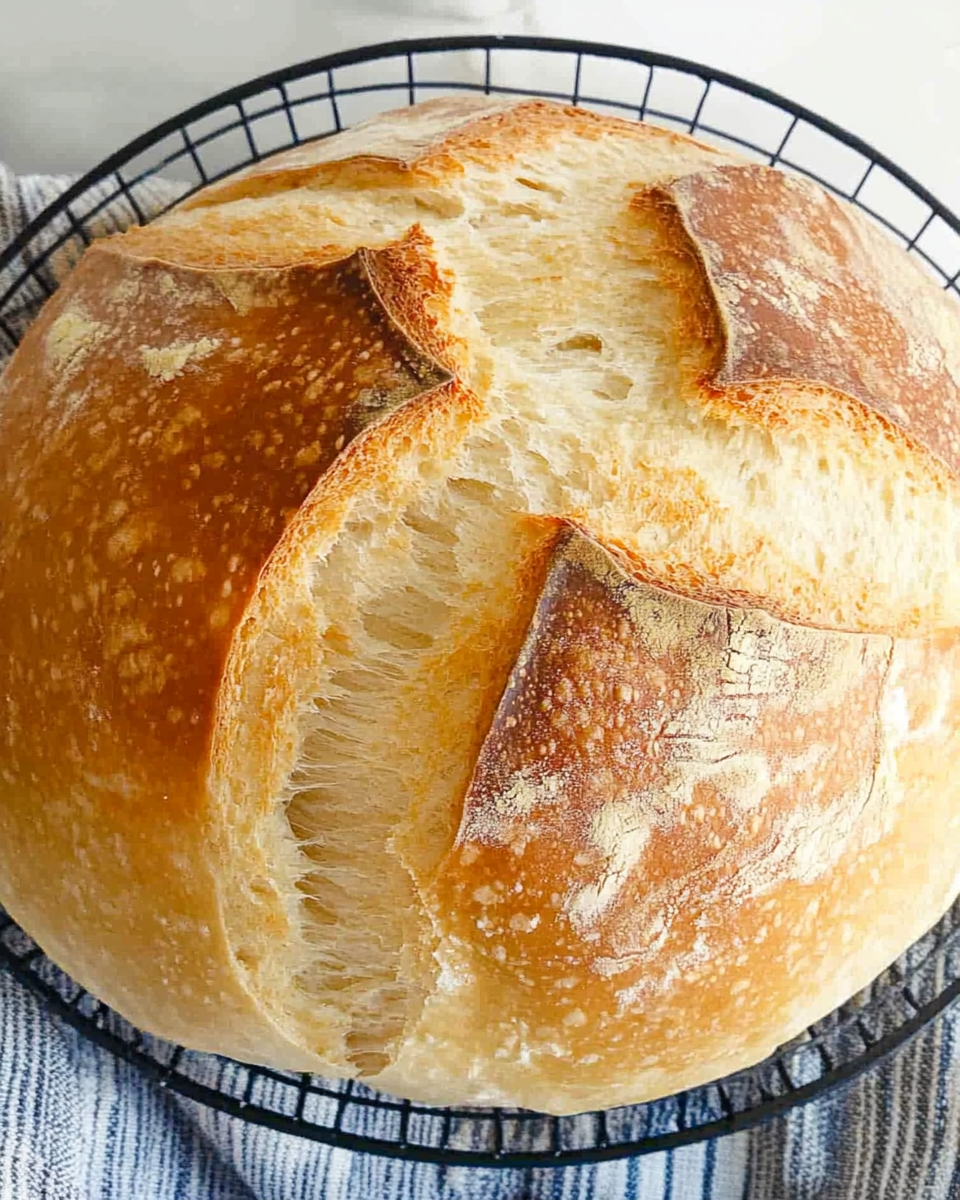There’s nothing quite like the aroma of freshly baked sourdough bread—crackly crust, soft interior, and that unmistakable tang. But traditional recipes often demand patience, with overnight fermentation and meticulous timing. Enter speedy same-day sourdough bread, a game-changer for bakers who crave homemade loaves without the wait. This recipe condenses the process into just 8 hours, leveraging an active sourdough starter and strategic techniques to deliver artisan-quality bread by dinnertime.

What sets this loaf apart? Unlike store-bought alternatives, it’s free of preservatives and packs the complex flavors of slow-fermented dough. The secret lies in controlled bulk fermentation and frequent stretch-and-folds, which strengthen gluten quickly. Baked in a Dutch oven, the bread develops a blistered crust and open crumb, rivaling bakery standards. Whether you’re a novice or a seasoned baker, this method demystifies same-day sourdough without compromising on texture or taste.
Essential Tools and Equipment
Precision is key in sourdough baking. Here’s what you’ll need:
- Kitchen Scale: Sourdough relies on exact ratios. Measure ingredients in grams for consistency.
- Mixing Bowl: Opt for a large, non-reactive bowl to accommodate dough expansion.
- Dutch Oven: Traps steam, creating the ideal humid environment for oven spring and crust development.
- Banneton (Proofing Basket): Maintains the dough’s shape during the final rise. A lined bowl works in a pinch.
- Bread Lame or Razor Blade: Essential for scoring, which controls how the bread expands during baking.
- Parchment Paper: Prevents sticking and makes transferring dough to the Dutch oven effortless.
Why these tools matter: A Dutch oven mimics professional steam-injected ovens, while a banneton prevents flattening during proofing. Without a bread lame, scores may tear unevenly, affecting the loaf’s rise.
Preparation Tips for Success
- Starter Readiness: Use an active sourdough starter that’s been fed 4–6 hours prior. It should be bubbly and pass the float test (a spoonful floats in water).
- Water Temperature: Slightly warm water (80°F/27°C) accelerates yeast activity, especially in cool kitchens.
- Autolyse: Resting the flour and water (without starter or salt) for 20–30 minutes jumpstarts gluten formation.
Ingredients
- 410g all-purpose flour: Substitute 10% with whole wheat for depth, but avoid overdoing it—higher whole grain content slows fermentation.
- 290g water: Adjust by ±10g based on humidity. Dough should be tacky but not sticky.
- 160g active sourdough starter (100% hydration): Equal parts flour and water by weight.
- 8g salt: Enhances flavor and regulates yeast activity.
Step-by-Step Instructions
Mix the Ingredients
- In a large bowl, combine water, sourdough starter, and salt. Stir until dissolved.
- Add flour and mix with hands or a spatula until no dry patches remain. The dough will be shaggy.
- Cover with a damp towel and rest for 30 minutes (autolyse).
Stretch and Fold
- Wet your hands to prevent sticking. Grab one edge of the dough, stretch it upward, and fold it over the center.
- Rotate the bowl 90° and repeat three more times (total of 4 folds).
- Re-cover and rest 20 minutes. Repeat this process three times over 1 hour.
Tip: Folds replace kneading, building gluten structure efficiently.
Bulk Fermentation
- Let the dough rise at room temperature (70–75°F/21–24°C) for 3–4 hours, until nearly doubled.
- To test readiness, gently poke the dough. If it slowly springs back, it’s proofed.
Shape the Dough
- Transfer dough to a lightly floured surface. Fold edges toward the center, rotating to form a tight ball.
- Place seam-side up in a floured banneton or bowl lined with a tea towel.
Final Proof
Cover and let rise at room temperature for 2 hours. For slower fermentation, refrigerate overnight (optional).
Bake
- Preheat Dutch oven at 460°F (238°C) for 1 hour.
- Turn dough onto parchment, score the top with a bread lame, and lower into the Dutch oven.
- Add a splash of water under the parchment for steam. Bake covered for 30 minutes, then uncovered at 440°F (227°C) for 10 minutes.
Cool
Rest on a wire rack for 1 hour before slicing. Cutting too soon releases steam, causing a gummy crumb.
Pro Tip: In cool kitchens, place dough in the oven with the light on to maintain a warm environment.
Freshly baked same-day sourdough bread deserves to be the star of the table. Its crisp crust and airy crumb make it versatile for both simple and elevated presentations.
- Classic Butter and Salt: Let the bread’s natural tang shine with high-quality cultured butter and flaky sea salt.
- Olive Oil and Balsamic: A drizzle of extra-virgin olive oil paired with aged balsamic vinegar enhances the bread’s earthy notes.
- Avocado Toast: Top thick slices with smashed avocado, red pepper flakes, and a sprinkle of hemp seeds.
- Bruschetta: Rub warm slices with garlic and layer with diced tomatoes, fresh basil, and a touch of olive oil.
For heartier meals, serve alongside soups, stews, or charcuterie boards. The bread’s sturdy structure holds up well to dips and spreads without becoming soggy.
Common Mistakes and How to Avoid Them
Even experienced bakers encounter challenges with quick sourdough bread. Here’s how to troubleshoot common issues:
Dense or Gummy Crumb
- Cause: Underproofed dough or weak starter activity.
- Fix: Ensure your starter doubles in size after feeding. Extend bulk fermentation by 30–60 minutes if needed.
Pale or Soft Crust
- Cause: Insufficient steam or low oven temperature.
- Fix: Bake covered for the full 30 minutes, and verify oven accuracy with a thermometer.
Dough Spreads Too Much
- Cause: Overhydration or insufficient shaping tension.
- Fix: Reduce water by 10g next time, and practice tighter shaping techniques.
Burnt Bottom
- Cause: Direct heat from the Dutch oven.
- Fix: Place a baking sheet on the rack below to diffuse heat, or reduce oven temperature by 15°F (9°C).
Sticky Dough That’s Hard to Handle
- Cause: High hydration or insufficient gluten development.
- Fix: Adjust flour-to-water ratio slightly, or perform an extra set of stretch-and-folds.
Pro Tip: Keep a baking journal to track adjustments and results for future batches.
Side Dish Recommendations
Pair your same-day sourdough with these complementary sides for a well-rounded meal:
- Roasted Garlic Hummus – Creamy and aromatic, perfect for dipping.
- Tomato Basil Soup – A classic pairing that highlights the bread’s tangy profile.
- Whipped Feta Dip – Salty, creamy, and balanced with a hint of lemon.
- Marinated Olives – Briny and herb-infused, adding Mediterranean flair.
- Charred Eggplant Spread – Smoky and rich, ideal for rustic toast.
- Prosciutto-Wrapped Asparagus – A savory, elegant accompaniment.
- Balsamic Glazed Mushrooms – Earthy and slightly sweet.
- Herbed Goat Cheese – Spreadable and fragrant with fresh thyme or rosemary.
These sides not only enhance the bread’s flavors but also turn a simple loaf into a centerpiece for gatherings.
How to Perfect the Recipe
- Experiment with Flour Blends: Substitute 10–20% of the all-purpose flour with rye or spelt for deeper flavor.
- Adjust Hydration: In dry climates, increase water by 10g; in humid environments, reduce slightly.
- Control Fermentation Speed: If your kitchen is cold, place the dough in the oven with the light on (off but warm).
- Master Scoring: Decorative scores aren’t just pretty—they guide expansion. Practice straight, confident cuts.
Remember: Sourdough is forgiving. Even “imperfect” loaves will taste delicious, and each bake builds intuition.
Perfecting same-day sourdough bread requires attention to detail, but these expert tips will help streamline the process:
- Starter Maintenance: Feed your sourdough starter regularly (every 12–24 hours) for optimal activity. If baking frequently, keep it at room temperature; otherwise, store it in the fridge and refresh 2–3 times before use.
- Temperature Control: Dough thrives in a warm environment (75–78°F/24–26°C). If your kitchen is cool, place the dough in a turned-off oven with the light on or near a warm appliance.
- Hydration Adjustments: Flour absorbs moisture differently based on humidity. If the dough feels too sticky, add 10–15g more flour during mixing.
- Scoring Techniques: A sharp bread lame held at a 30° angle creates clean cuts. For an ear (a raised crust), make a shallow, swift slash.
- Alternative Baking Methods: No Dutch oven? Use a baking stone or steel with a steam pan underneath for similar results.
Storage and Reheating Instructions
Proper storage keeps your artisan sourdough fresh longer:
- Room Temperature: Store in a paper bag or bread box for up to 2 days. Avoid plastic bags, which trap moisture and soften the crust.
- Freezing: Slice the cooled loaf, wrap tightly in foil, and freeze for up to 3 months. Reheat slices directly from frozen in a 350°F (177°C) oven for 5–7 minutes.
- Reviving Stale Bread: Sprinkle with water and bake at 375°F (190°C) for 5–10 minutes to restore crispness.
Note: Refrigeration accelerates staling—only freeze or keep at room temperature.
Frequently Asked Questions
Can I use unfed starter?
No. An active, bubbly starter (peaked 4–6 hours after feeding) is essential for proper rise. Unfed starter lacks the yeast activity needed for same-day fermentation.
Why is commercial yeast not used?
Traditional sourdough relies on wild yeast and bacteria for fermentation, yielding superior flavor, texture, and digestibility. Commercial yeast would alter the character of the bread.
How do I fix overproofed dough?
If the dough collapses when poked, it’s overproofed. Reshape it, let it rise for 30 minutes, and bake immediately. The loaf may be denser but still edible.
Can I halve the recipe?
Yes, but reduce baking time by 5–10 minutes. Smaller loaves bake faster.
Why is my bread too sour?
Longer fermentation increases sourness. For milder flavor, shorten bulk fermentation by 1 hour or use a younger starter (fed 4 hours before mixing).
How do I know when the bread is done?
The internal temperature should reach 205–210°F (96–99°C). The crust should be deep golden brown and sound hollow when tapped.
Can I add mix-ins like nuts or seeds?
Yes. Fold in up to 100g of additions (toasted nuts, dried fruit, or seeds) during the first set of stretch-and-folds.
Conclusion
This speedy same-day sourdough bread recipe proves that artisan-quality loaves don’t require days of waiting. By optimizing fermentation with stretch-and-folds and precise baking, you can enjoy a crusty, tangy sourdough in just 8 hours.
Key takeaways:
- A healthy starter and warm environment are critical for success.
- Proper shaping and scoring ensure an even rise and attractive finish.
- Storage methods preserve freshness without sacrificing texture.
Whether you’re a beginner or a seasoned baker, this approach demystifies same-day sourdough while delivering bakery-worthy results. Share your creations and tag #SameDaySourdough to inspire others!
LSI/NLP Keywords:
- Quick sourdough recipe
- Same-day artisan bread
- Dutch oven baking
- No-knead sourdough
- Fast sourdough starter
- Crusty homemade bread
- Sourdough without overnight proofing
- Easy bread scoring techniques
Category: Bread
Speedy Same-Day Sourdough Bread
Ingredients
- 410 grams all-purpose flour
- 290 grams water
- 160 grams sourdough starter active and bubbly
- 8 grams salt
- Equipment
- 1 Dutch oven
- 1 bread lame or sharp knife
Instructions
- Mix the Ingredients
- In a large bowl, combine the water, sourdough starter, and salt. Stir until evenly mixed.
- Add the flour and mix until combined, using your hands to fully incorporate any dry bits.
- Cover the bowl and let the dough rest for 30 minutes.
- Stretch and Fold
- After resting, perform one set of stretch and folds:
- Grab one edge of the dough, stretch it upward, then fold it over the opposite side.
- Rotate the bowl 90° and repeat for a total of 4 folds.
- Cover and let rest for 20 minutes.
- Repeat this process three more times over the next hour.
- Bulk Fermentation
- Cover the bowl and let the dough rise at room temperature for 3 to 4 hours, or until nearly doubled in size.
- Shape the Dough
- Transfer the dough to a lightly floured surface.
- Shape it into a tight round by folding the dough’s edges toward the center and pinching them together.
- Repeat from all sides to create a smooth ball.
- Final Proof
- Line a banneton or bowl with a floured tea towel.
- Place the dough seam-side up in the basket, cover with a cloth or plastic, and let rise for 2 hours at room temperature.
- Preheat the Oven
- In the final hour of proofing, preheat your oven to 460°F (238°C) with the Dutch oven inside.
- Score and Bake
- Flip the dough onto parchment paper so the seam side is down.
- Score the top with a bread lame or sharp knife in a crisscross or decorative pattern.
- Place the dough (with parchment) into the hot Dutch oven.
- Add a splash of water under the parchment to generate steam.
- Cover and bake at 460°F (238°C) for 30 minutes.
- Remove the lid and reduce heat to 440°F (227°C); bake for another 10 minutes until golden and crisp.
- Cool
- Transfer the loaf to a wire rack and cover with a damp towel.
- Let cool for at least 1 hour before slicing to allow the crumb to set.
- Notes
- To speed up rising in a cool kitchen, place the dough in a slightly warm (but off) oven or near a heat source.
- Dough is ready when it has doubled and passes the poke test (a gentle press springs back slowly).
- Store bread in a paper bag at room temperature for up to 2 days or freeze for longer storage.






